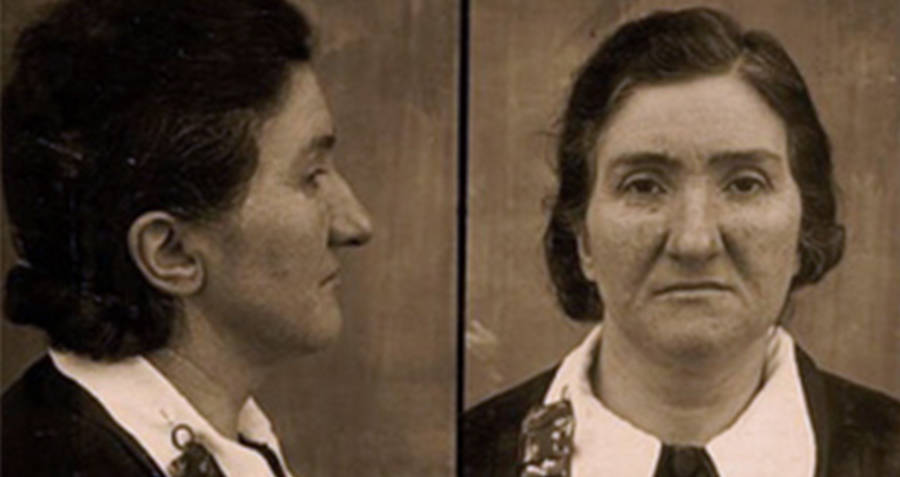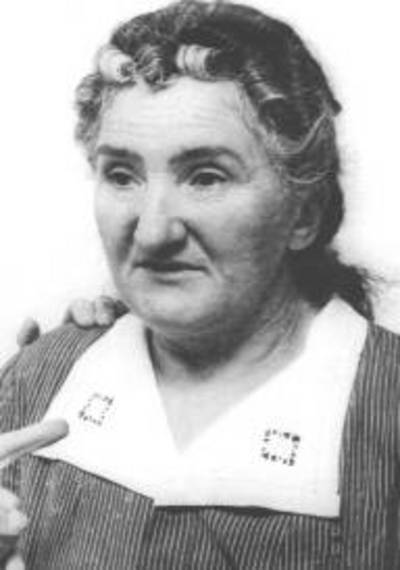Known as the "Soap-Maker of Correggio," Leonarda Cianciulli was an Italian serial killer who lured women to her home to sacrifice them.

Wikimedia CommonsLeonarda Cianciulli’s mugshot.
Before she was known as “The Soap-Maker of Correggio” who killed three women and turned their remains into soap and teacakes, Leonarda Cianciulli was a devoted Italian mother who wanted to keep her son safe during World War II.
Her story begins at the turn of the 20th century. While she was married, she got pregnant 17 times. Of those 17 times, three of the pregnancies were lost due to miscarriages, and 10 of the children died in their youth.
So when it came to her four surviving children, they couldn’t have asked for a more protective mother.
In 1939, Cianciulli’s son Giuseppe Pansardi — her eldest son and favorite child — announced that he was going to enlist in the Italian Army. Like many Italians during that time, he wanted to do his part in the World War II effort.
This announcement, combined with her belief in superstitions, set the wheels in motion for Leonarda Cianciulli to become one of the most infamous female serial killers of the 20th century.
Leonarda Cianciulli’s Early Life
Born on April 18, 1894, in the quaint southern Italian town of Montella, Leonarda Cianciulli had a tragic life from the start.
She attempted suicide twice before she became an adult. When she married registry clerk Raffaele Pansardi in 1917, Cianciulli claimed her mother cursed her because she disapproved of the marriage.
In 1927, Cianciulli was imprisoned for fraud. Upon her release, she and her family moved from Potenza to Lacedonia, not too far from her childhood home. On July 23, 1930, the Irpinia Earthquake struck. It would later be categorized as one of the most destructive earthquakes in Italian history. Cianciulli was one of the thousands who lost their homes in the disaster.

Wikimedia CommonsThe 1930 Irpinia Earthquake, which cost Leonarda Cianciulli her family home.
Between her suicide attempts, her mother’s alleged curse, and her various miscarriages, Leonarda Cianciulli realized that her life — to put it bluntly — sucked. So she went to see a fortune-teller for some insight. The fortune-teller, a traveling Romani woman, did nothing to quell her fears.
“In your right hand I see prison,” the fortune-teller told her. “In your left, a criminal asylum.”
Superstition Or Mental Illness?
Today, it’s well understood that a woman can suffer from depression and anxiety after just one miscarriage, let alone three. And this is to say nothing of how her grief would have been compounded by the deaths of 10 of her children that she brought to term.
If Leonarda Cianciulli were alive today, she’d most likely be diagnosed with clinical depression, sent to undergo therapy, and put on a regimen of medication.

Wikimedia CommonsLeonarda Cianciulli was interviewed by professors before her death.
But in the 1930s, while living in a small province nestled in the Matese and Picentini mountains in southern Italy, Leonarda Cianciulli resorted to superstition and paranoia.
As it turns out, there is some evidence to suggest that Cianciulli’s superstitious beliefs were a sign of deep-seated anxiety and depression. Today, many clinical psychologists believe that superstitions are born out of a fractured mind’s attempts to make sense of the nonsensical.
But of course, it’s impossible to know whether modern medical treatment could have prevented what happened next.
A Gruesome Series Of Murders
Dwelling on her mother’s alleged curse and the Romani fortune-teller’s prediction, Leonarda Cianciulli became deeply superstitious. When her son Giuseppe told her in late 1939 that he was going to join the Italian Army, Cianciulli turned to the one thing that she believed would keep him safe: human sacrifice.
It’s unclear where Cianciulli got her idea to sacrifice humans in order to save her son from dying in World War II. The Roman Catholicism prevalent in Italy during Cianciulli’s time forbade human sacrifice as an abomination before God. Additionally, there’s no known Romani belief or superstition that embraces human sacrifice.
But regardless of where she got her idea, Leonarda Cianciulli would go on to murder three women before she was caught.
The Soap-Maker’s Victims
Leonarda Cianciulli’s first victim was a local spinster woman named Faustina Setti. Inviting Setti to her home under the guise of setting her up with a husband in 1939, Cianciulli instructed her to write letters to her family members, telling them that she would be visiting the man abroad. But Cianciulli drugged Setti with spiked wine before murdering her with an ax.
Next, she cut Setti into nine pieces and gathered her blood into a basin. In her official statement after her arrest, she described the things she did next:
“I threw the pieces into a pot, added seven kilos of caustic soda, which I had bought to make soap, and stirred the whole mixture until the pieces dissolved in a thick, dark mush that I poured into several buckets and emptied in a nearby septic tank.”
“As for the blood in the basin, I waited until it had coagulated, dried it in the oven, ground it and mixed it with flour, sugar, chocolate, milk and eggs, as well as a bit of margarine, kneading all the ingredients together. I made lots of crunchy tea cakes and served them to the ladies who came to visit, though Giuseppe and I also ate them.”
Cianciulli also reportedly took Setti’s life savings of 30,000 Italian lire (the equivalent of $17.94, and when adjusted for 2020 inflation, about $332), which she had received as payment for setting Setti up with a husband.
On Sept. 5, 1940, Cianciulli found another victim named Francesca Soavi. As with Setti, Cianciulli convinced Soavi that she had organized a teaching job for her abroad, and made her write letters to her friends detailing her trip. And, as she had with Setti, she fed her drugged wine, killed her with an ax, baked her into teacakes, and stole her money.
Her third victim, however, would be her last one.

Wikimedia CommonsLa Scala, a noted opera house in Milan, Italy, where Leonarda Cianciulli’s last victim once performed.
Virginia Cacioppo was a noted soprano who once sang at the famed La Scala opera house in Milan. Cianciulli had promised her a job working with an impresario in Florence, which prompted Cacioppo to pay her a visit on Sept. 30, 1940. As with her previous two victims, Cianciulli fed Cacioppo spiked wine and killed her with an ax.
This time, however, instead of only baking her body into teacakes and feeding them to her neighbors, Cianciulli also melted her flesh down and turned it into soap.
“She ended up in the pot like the other two… her flesh was fat and white, when it had melted I added a bottle of cologne, and after a long time on the boil, I was able to make some most acceptable creamy soap. I gave bars to neighbors and acquaintances. The cakes, too, were better: that woman was really sweet.”
Leonarda Cianciulli’s Arrest, Death, And Legend
Although Leonarda Cianciulli thought she had committed the perfect murders, she could not have been more wrong.
Unlike her first two victims who had few concerned relatives, Cacioppo had a very worried sister-in-law. She didn’t believe Cacioppo’s letters detailing her quick departure, and had, in fact, seen her entering Cianciulli’s home the night she had “left.” Almost immediately, she reported her sister’s disappearance to the Reggio Emilia police, who quickly investigated Cianciulli.
At first, Leonarda Cianciulli defended herself. It was only when the police shifted the blame toward her beloved son Giuseppe that she finally broke down and admitted to everything.
Cianciulli’s trial lasted only a few days. She was found guilty of her crimes and granted a 33-year sentence that echoed the Romani woman’s prophecy with eerie accuracy: 30 years in a prison and three years in a criminal asylum.
On Oct. 15, 1970, Leonarda Cianciulli died of cerebral apoplexy, a type of hemorrhage, while she was still in the asylum. She was 79 years old.
Her body was returned to her family for burial, but her murder weapons — including the pot that her victims were boiled in — were donated to the Criminology Museum in Rome. To this day, museum visitors can see her collection of axes and peer inside the vat that she used to boil human beings.

Wikimedia CommonsLeonara Cianciulli’s victims and her preferred murder weapons in the Italian Criminology Museum.
But the story doesn’t end there.
In 1979, Lina Wertmüller — best known for her work on the infamous Italian film The Seduction of Mimi — produced the play Love & Magic in Mama’s Kitchen, which was based on the life of Leonarda Cianciulli, for the Spoleto Festival.
And, in 1983, Love & Magic in Mama’s Kitchen began a Broadway run, bringing Leonarda Cianciulli from the secluded hills of Avellino to the Great White Way.
If you thought Leonarda Cianciulli was a brutal serial killer, wait until you read about Elizabeth Bathory, who was so brutal she was known as the Blood Countess. Then, check out Leonard Lake, the hippie pornographer-turned-serial killer.






